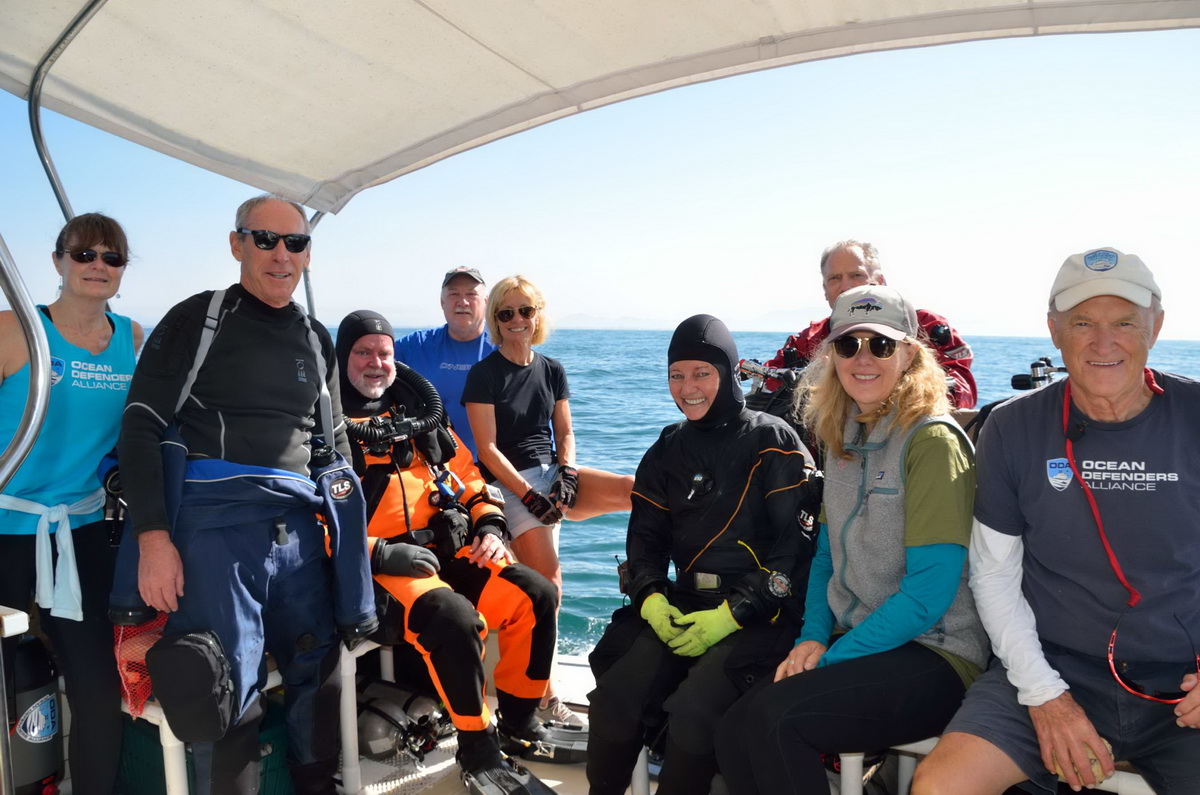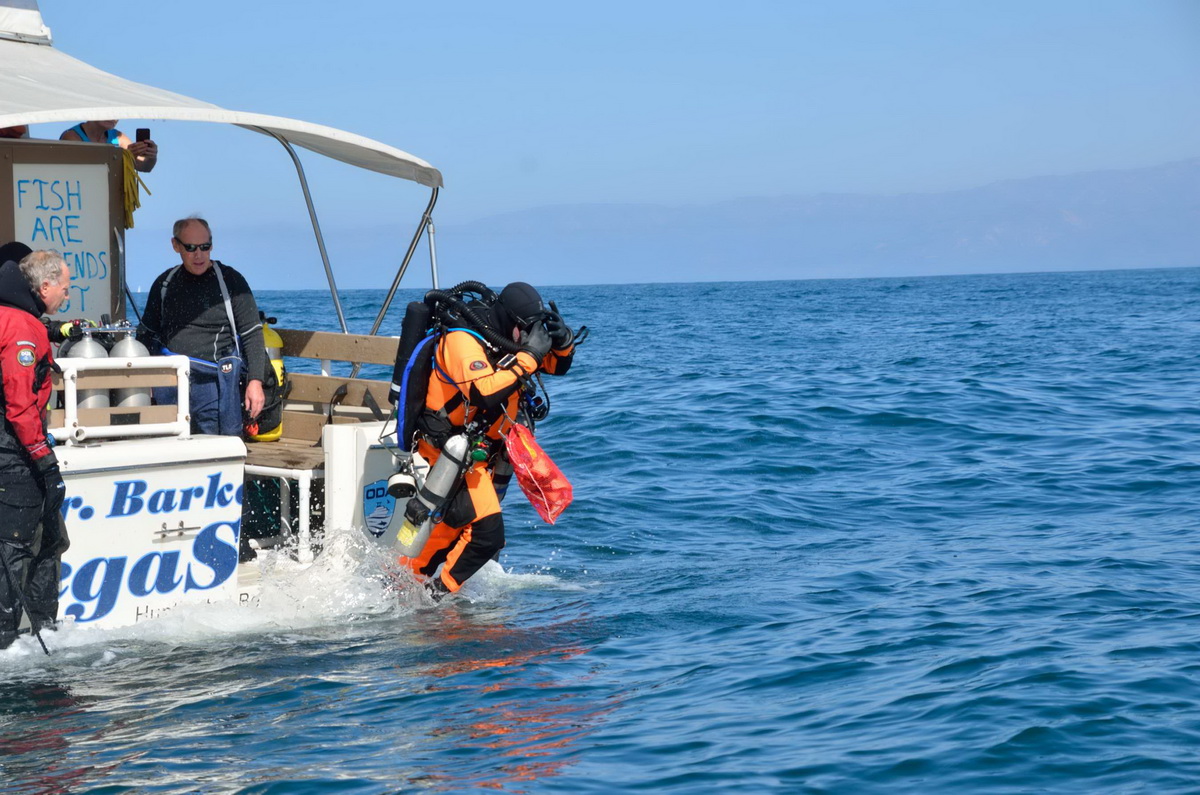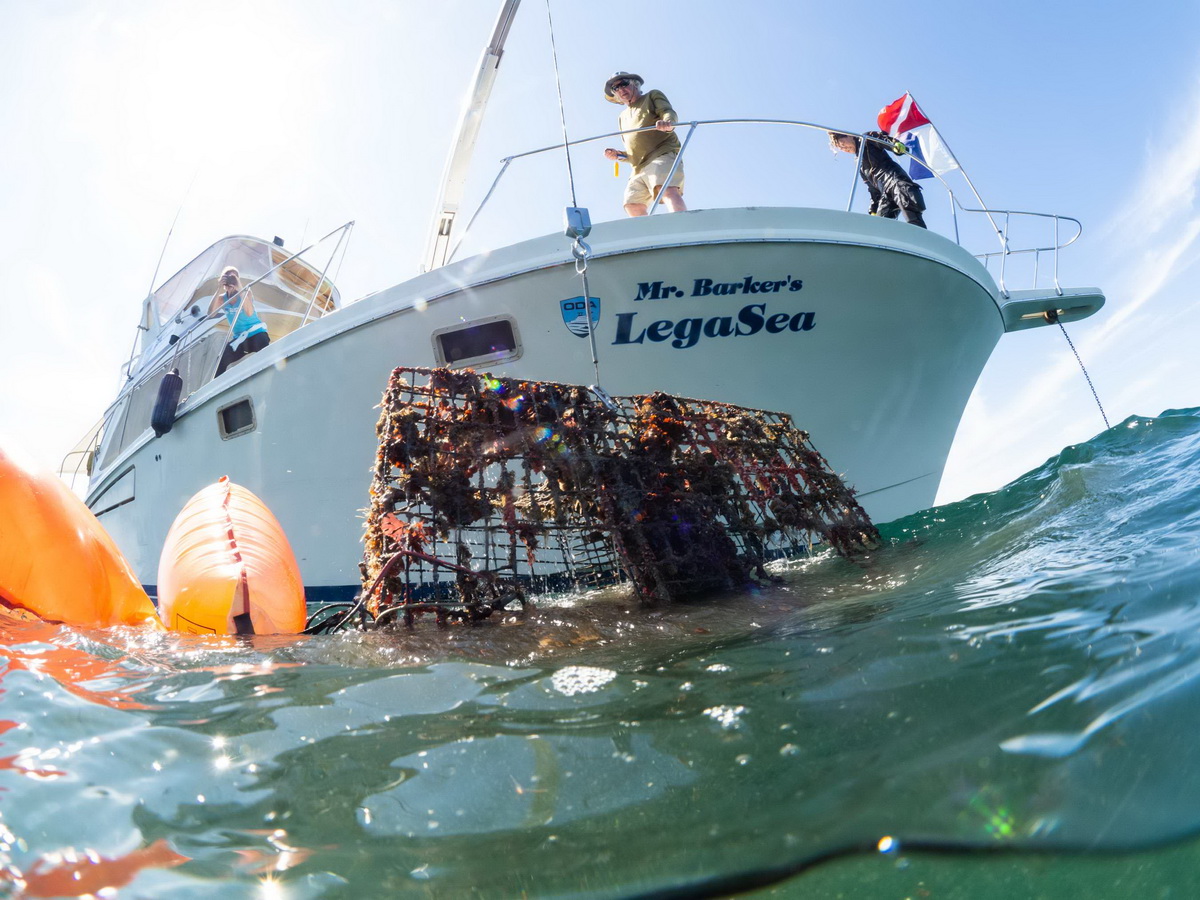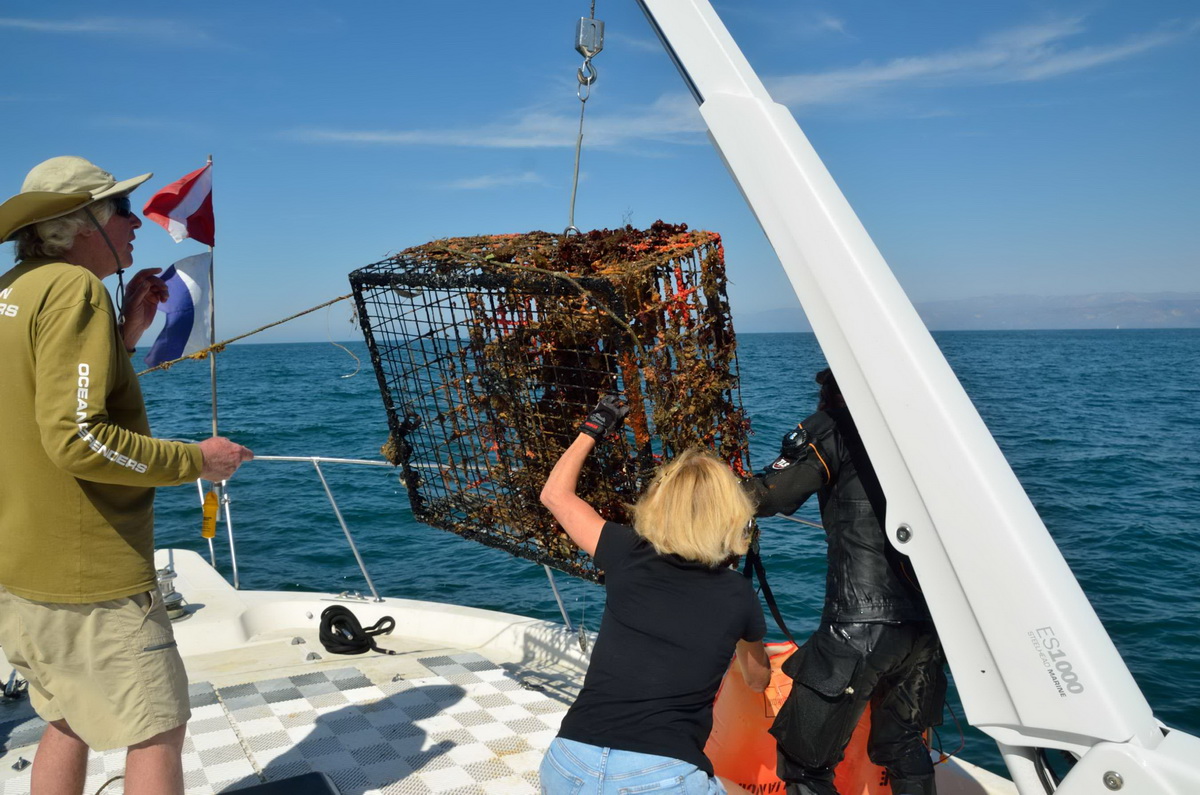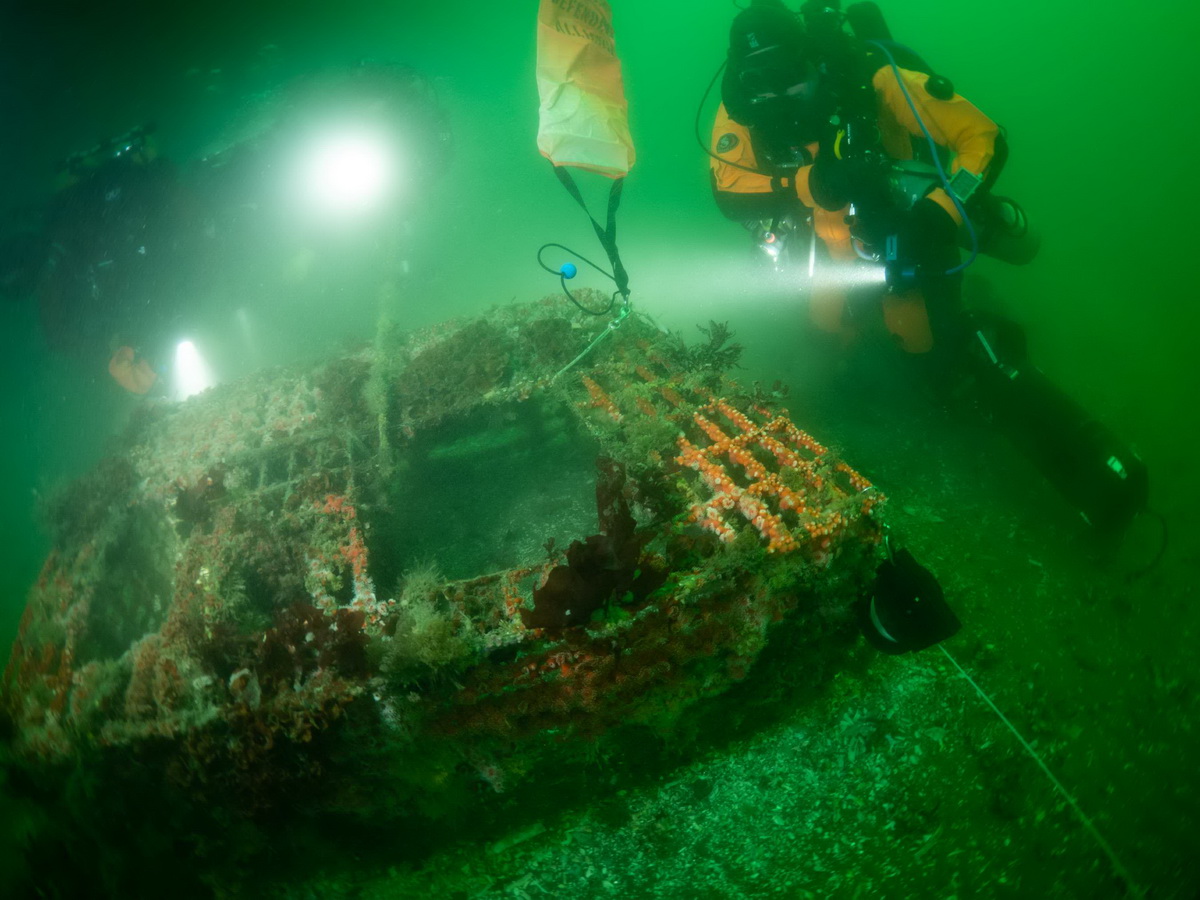By Founder and President Kurt Lieber
On Sunday, October 3rd, a boatload of divers and ocean lovers climbed aboard the Ocean Defender Alliance (ODA) flagship Mr. Barkers LegaSea and headed about four miles out to a dive site we started cleaning up a couple of weeks ago.
As we exited the Channel Islands Harbor in Ventura County, California, we were treated to just incredible visibility. The Santa Ana winds had been blowing the previous week, and it created open skies. I’d estimate that we could see 50 miles in every direction.
Not only could we see Anacapa Island, but also the far end of Santa Cruz Island was in sight. Easily 40 miles away. You could even make out the yellowish color of the cliff face of Yellow Banks, on the east end of Santa Cruz Island. A rare day, indeed.
Those winds also made for flat seas, and we motored to the site with no more than a 2-foot swell. Quite a contrast from recent weeks when we had to turn back because of 5–6-foot seas…
We arrived at the dive site around 10 o’clock. That’s when my phone started going berserk. I started getting text messages, emails, and voice messages about an oil spill in Orange County. I had heard about a reported oil slick on Friday night. But the Coast Guard said it was small and would most likely evaporate overnight. Now we know the truth. It's a horrible situation.
Some history on the La Janelle
In 1930, a luxury cruise liner named the Borinquen was launched from a shipyard in Quincy, Maine. This was a massive, steam powered liner. Roughly 340 feet long and 60 feet wide, it hosted 1,000 passengers as it cruised between New York and Puerto Rico.
 La Janelle historic photo. With permission from WreckSite.
La Janelle historic photo. With permission from WreckSite.
Around 1970 it was sold and renamed the La Janelle and was said to become a floating restaurant. The new owners had it anchored just outside of Port Hueneme, in Ventura County.
 La Janelle, modern day photo. With permission from WreckSite.
La Janelle, modern day photo. With permission from WreckSite.
On April 13, 1970, a massive storm came in off the Pacific that caught the boat crew off guard. They only had one anchor laid out and it soon broke loose of the bottom.
The ship ran aground just outside the entrance to Port Hueneme. Check out this amazing photo someone captured!
 La Janelle in a storm. With permission from WreckSite.
La Janelle in a storm. With permission from WreckSite.
Because of its size, the salvage teams tried to get it off the sand but gave up and decided to cut it into pieces. Part of the wreck was left in the sand and became part of the breakwall.
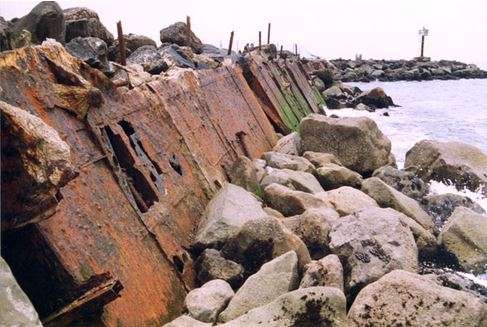 Pieces of the La Janelle mixed in with the breakwall. With permission from WreckSite.
Pieces of the La Janelle mixed in with the breakwall. With permission from WreckSite.
The rest of the wreck was towed out in sections and sunk about four miles offshore, and that's where we were headed.
La Janelle’s new resting place
In this offshore location, the pieces of the wreck lie scattered over a large area, in roughly 80-85 feet. This is now an artificial reef, with lots of fish, crabs, and garibaldi (known historically also as the Catalina goldfish and marine goldfish) finding it suitable habitat.
Of course, lobsters like to hang out in all the nooks and crannies. It makes sense that we’ve been finding abandoned traps as no doubt the lobster fishermen know that many lobsters reside in this area.
Continuing to Remove Abandoned Fishing Gear
Divers this day were: Kim Cardenas, Erich Fertschneider, Kendall Raine, Geoff Walsh, and Mike Wynd. Helping out on the boat were: Megan Davis, Dave Merrill, Sue St. Sure, and Carolyn Vondriska.
Once on the site, we dropped anchor at a spot we hadn’t investigated before. This is our second time checking out the general area. The first time yielded good results. We were hoping the same this time out.
Mike dropped down first, into 80 feet of water. Since he dives using a rebreather system, he can stay down much longer than our other divers as they all use compressed air.
Kim, Erich, Kendall, and Geoff followed suit about 15 minutes later. Ten minutes later we saw three lift bags pop up, about 100 feet from our boat. Three lift bags? Must be something really heavy!
 Erich doing his magic trick - walking on water! ;-)
Erich doing his magic trick - walking on water! ;-)
Sue, Dave, and Carolyn hopped into the RIB (rigid inflatable vessel) and set to hooking a tow line to the bags so they could haul it over to Megan and me on the LegaSea. As the RIB got close, we could see it was indeed a very big trap. One of the largest we’ve ever encountered.
Sue maneuvered the RIB close enough to the boat so that Dave was able to attach the davit line to the trap.
We then hauled it aboard using the davit (like a crane), onto the front deck. It was HUGE! Looked like it had been in the water for about two years.
Luckily there were no lobsters in it, but as we laid it on the deck a small octopus emerged! Megan picked him/her up ever so gently and sent the critter on its way back into its watery home.
Shortly thereafter the divers were busy with another type of debris.
We saw another lift bag break the surface. This time it turned out to be a lobster trap, but not a commercial one; this was one used by recreational fishermen. It’s called a hoop trap. It had about 100 feet of trap line with it.
Rest, Recharge, and Remove More Debris
After 30 minutes all the divers surfaced, and sat down to rest and get some food. After discussing what the divers saw and found, we decided to move the boat to another spot.
I spent the next 20 minutes hunting around the general area looking for a nice spike on my depth finder screen. I finally found a spike indicating that there was something down there that rose up a sharp 10 feet off the bottom. The deck crew quickly dropped the anchor.
After a 90-minute surface interval (break from diving), all five divers descended. Mike preceded them by about 10 minutes again this time. Within minutes we had more lift bags at the surface. The RIB crew did their thing and soon we had another trap on the davit line.
There was a lot of small organisms on this one, mostly an invasive seaweed. This is one of the problems with leaving anything manmade in the water. Invasive species are very aggressive and the first to attach themselves to any new surface. The native species aren’t used to having to compete with non-natives and lose out on the battle for new turf. Once the invasives take hold, they proliferate.
As their 30 minutes of bottom time came to an end, all the divers surfaced at the same time.
Mission Accomplished
We headed home happy as clams. We got three more traps out of the ocean, about 250 feet of trap lines, 200 feet of fishing lines, and some trap remnants.
We don't often document the hauling away of the debris, but just so you know...this is how we end every successful outing!
Thank you to Erich for the excellent underwater pictures. Our appreciation, too, to Megan and Carolyn who got in on the photo action from the RIB and on the decks. Geoff took some UW video, which I’ll post shortly so please check back soon.
It was a great day to be out on the water. With clear skies and good underwater visibility, everyone had something to cheer about. Let’s do it again!
And with your help from wherever you are, we'll be able to once again go to sea to remove hazardous and deadly debris. Please make a donation to help fuel our boats and keep our operations going! Thank you!



